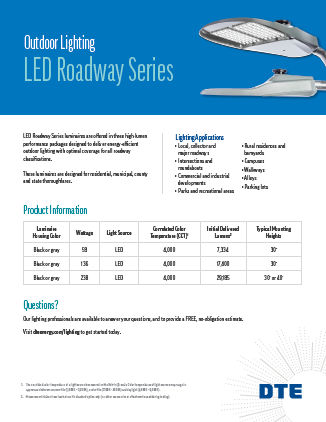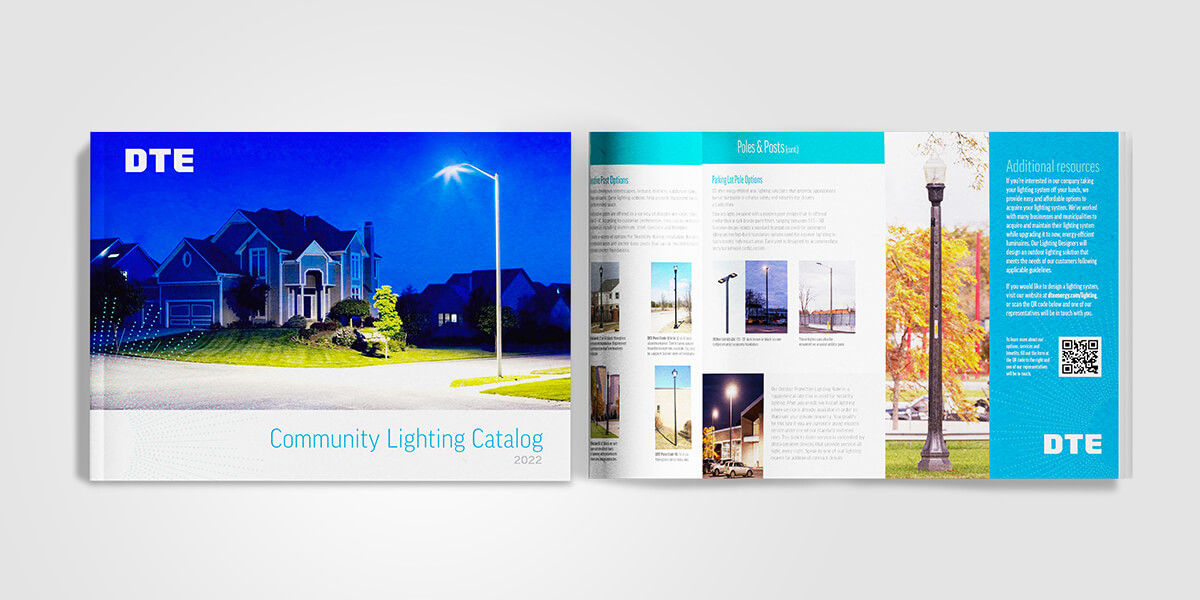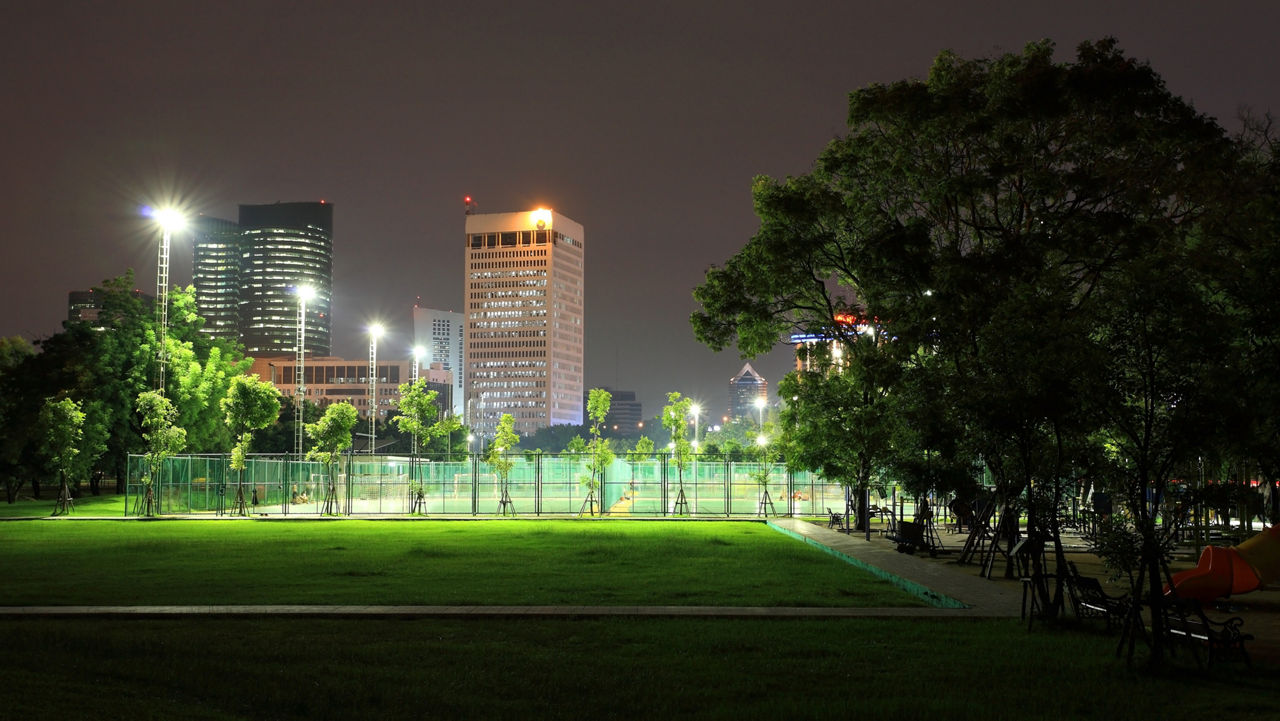Illuminate a Brighter, Safer, More Welcoming Community
Outdoor lighting delivers valuable benefits to municipalities. Greater safety, security and a more welcoming environment help attract residents, visitors and business, all of which contributes to increased municipal revenue.
Report Your Outdoor Lighting Outage
Illuminate and Brighten Vibrant Communities
Enhance Your Public Spaces

A proper lighting plan must accommodate many factors, like aesthetics, safety, performance and cost. The lighting experts at DTE Energy can help your municipality find that ideal balance of beauty and function while keeping the project affordable. When light in public spaces serves all your citizens’ needs, you’ll see those spaces flourish.
Energy Efficiency

DTE has the right lighting solutions for your specific needs. Our large portfolio of energy-efficient lighting products deliver optimal performance while keeping your costs low. And there will be no surprises with DTE’s affordable and predictable monthly fees.
Streetlight Receptacle Usage
Please report receptacle usage for the year, including holiday lighting usage, by submitting a request form.
Tips and Tools
Explore our Lighting Solutions
Product Sheets
Each product sheet contains detailed information, including location application, installation requirements, performance specs and color distribution. Learn more about our lighting portfolio in the product sheets below or design a light using our interactive tool.
Acorn
Colonial Series
LED Roadway Series
NEMA Head Series
HPS Roadway Series
LED Area Light Series

Solution Sheets
Through DTE Energy’s Outdoor Lighting program, energy-efficient municipal lighting that will serve as a foundation of growth and investment in your community is only a phone call away.
Municipality (Downtown)
Municipality (Walkway)
Municipality (Roadway)
Security Lighting Solutions
Security Lighting Solutions (Spanish)
Street Lighting Case Study: The City of Warren
Street Lighting Case Study: The City of Westland

Lighting Terms and Definitions
The effect a light source has on the color appearance of an object when compared to its color appearance under a reference light source. The Color Rendering Index (CRI) scale ranges from 0 to 100 - higher values indicating better color rendering with less color shift to object.
The color appearance of light produced by a light source measured by the Kelvin Scale (K). Color temperatures of light sources may range in appearance between warm white (1,800K – 3,000K), cool white (3100K - 4500K) and daylight (4,600K - 6,500K).
Total luminous flux emitted divided by the total power input of a luminaire. It is expressed in lumens per watt (L/W).
The total amount of light emitted by a luminaire divided by the total amount of light emitted by a light source (lamp, light emitting diode, etc.). Less light is absorbed, internally, by higher efficiency luminaires.
A unit of measure for luminance equal to a uniformly distributed flux of one lumen incident upon one square foot of surface area.
A high intensity discharge (HID) light source produces an electric arc to generate light in a stabilized arc tube. HID lighting sources include mercury vapor, metal halide, and high pressure sodium.
A device that produces light by means of an electric arc generated through electrodes housed inside a translucent or transparent arc tube. High-intensity discharge lamps, incandescent lamps and fluorescent lamps are typically used for outdoor lighting.
A factor used in lighting calculations to account for the light loss that takes place in a lamp due to the gradual decay in lumen output over a specified period of burning time.
A component of a luminaire used to redirect light to control the light distribution. Lenses are composed of glass, acrylic, or polycarbonate materials.
A light source that becomes illuminated by the movement of electrons through a semiconductor material.
A product of several depreciation factors used in lighting design to predict a luminaires performance over a predetermined number of operating hours. These factors include lamp lumen depreciation (LLD), luminaire dirt depreciation (LDD), atmospheric conditions, voltage regulation, maintenance procedures, etc.
An encroachment of unwanted light, across property boundary lines, that may cause a nuisance or loss of privacy to neighboring properties.
A luminaire classification system describing the lateral and vertical light projected or dispersed from a luminaire. Typical roadway and area light luminaire classifications range from Type 1 to Type 5 lighting distributions.
The unit of measurement for light output or luminous flux.
A luminaire is a complete electric light unit consisting of varying components assembled as a system to generate light, direct and/or diffuse light, house and protect the lighting components, and connect the lighting components to a power supply.
A factor used in lighting calculations to account for the light loss due to the accumulation of dirt on the luminaire. The LDD is contingent upon environment, cleaning schedules and the type of luminaire used.
The vertical distance between the luminaire and the surface to be lighted. It includes both the pole length and the base above grade to which the pole is mounted.
A component of a luminaire used to control light output or distribution. A luminaire may consist of a lens, mirror, glass or plastic globe, or a combination of these components to control light.
Rules, regulations and codes enacted into law by local governing bodies that define outdoor lighting standards and submittal requirements. Ordinance rules are typically restricted by zoning classifications; residential, commercial and industrial.
A specular or diffuse surface used to reflect or redirect light produced from a light source.
A prismatic lens used to refract or change light direction produced from a light source.
A measure of how consistent or uniform lighting is distributed over a task area. Uniformity ratios are used in lighting design to improve the range of human vision. For example, observing an area with bright spots beneath outdoor lighting fixtures surrounded by dark spots is an indication of poor lighting uniformity.
A unit of power, equivalent to one joule per second, corresponding to the rate of consumption of energy in an electric circuit.



